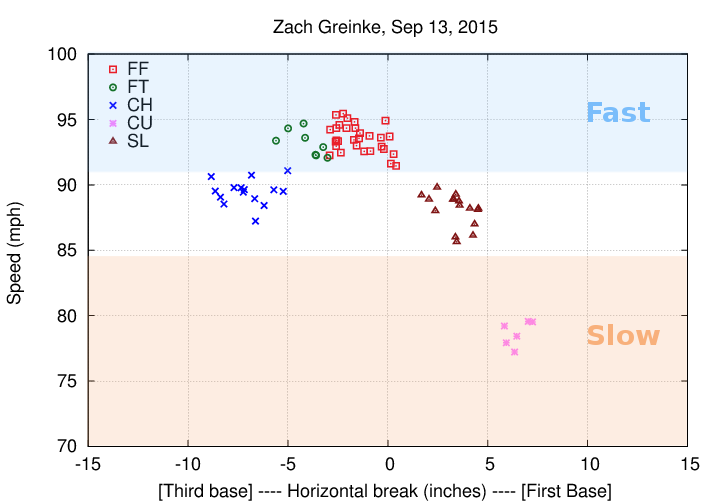
Why does a curveball curve? What's the difference between a cutter and a slider? The art of pitching is filled with arcane terms, and even when two players are talking about the same thing, they often use different words. In this series of articles, we're going to look carefully at the motion of a baseball through the air: how does it behave and what can a pitcher do to control it?
Today, we look at the slider. It's a pitch which seems to fall between some of the common classes; not really a fastball, but not really a curveball. What is it? How does it behave, and how does a pitcher throw it? Just what is the connection between the slider and the fabled gyroball? Although a deep understanding of this pitch requires some vector calculus, don't worry -- I'll use pictures instead of equations to explain.
Perhaps the most fundamental property of a pitch is its speed. In the graph below, the speed of each pitch is shown on the vertical axis. If we look at the pitches thrown by Zach Greinke of the Arizona Diamondbacks in a game against the Dodgers last year, we see that there are some really slow ones (curveballs, pink symbols) and some really fast ones (fastballs, red and green symbols).

Two groups of pitches fall in the middle: changeups (blue crosses on the left), and sliders (brown triangles on the right). It seems that sliders aren't particularly fast, nor particularly slow.
Another property of pitches is their break; that's the difference between their trajectory and that of a ball thrown with the same initial velocity, but no spin. As you may recall from earlier articles in this series, a basic fastball breaks up, while a basic curveball breaks down. A pitcher's arm angle can modify these motions, so that a right-hand pitcher's (RHP's) fastball moves towards third base, as well as up.
What does a slider do? Let's switch to a slightly different graph to find out. In the figure below, the vertical axis shows vertical break (not speed), while the horizontal axis shows horizontal break. Focus on the brown triangles.
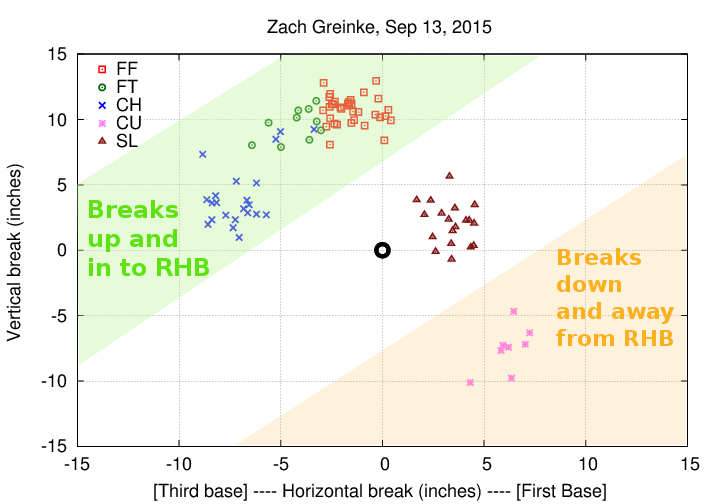
The slider is a peculiar cross between fastball and curveball: it breaks up, like a fastball, but moves horizontally towards first (for RHP), like a curveball. A batter who guesses "curveball" will swing below the slider, while a hitter who thinks it's a fastball will see the ball glide away from the tip of his bat.
Sounds great! But how can a pitcher make the ball behave in this way?
Let's begin by reviewing the mechanics of throwing a fastball. The goal for that pitch is to make the ball come out of the hand with the greatest possible speed. A good way to maximize speed is to create the longest, straightest launching system, running from the shoulder, through the arm, elbow, wrist and palm, all the way to the tips of the fingers. In the figure below, shown from the batter's point of view, a right-hander is about to release a fastball.
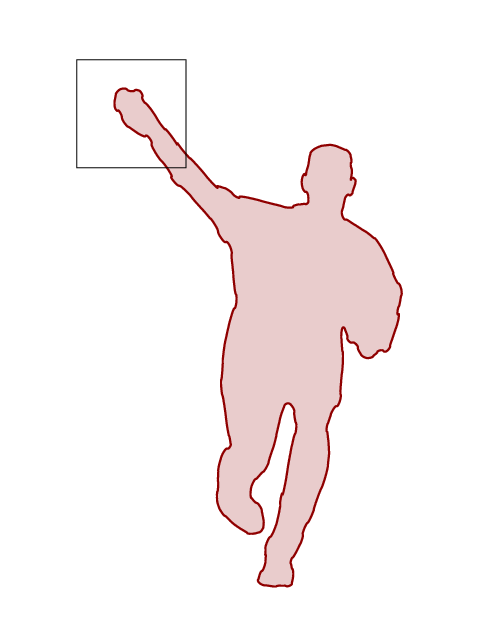
Let's zoom in on his hand as the ball starts to come out. Click on the picture below to start a brief animation, showing the ball rolling out between the index and middle fingers.
As the ball rolls off the fingers, its spin axis points towards third base, and slightly below the horizontal.
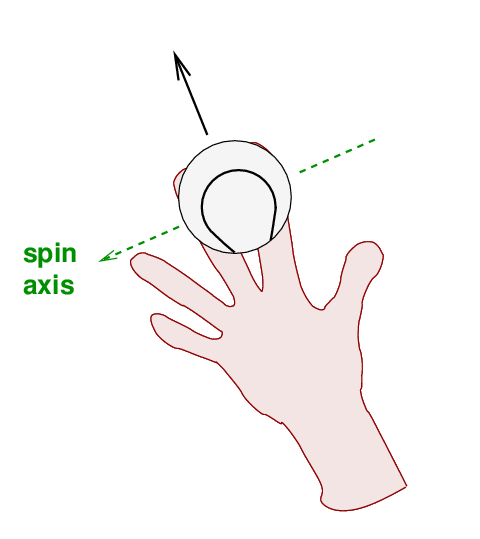
It is the direction of this spin axis which determines the break of the ball. A perfectly horizontal axis -- corresponding to perfect backspin -- would yield a fastball with a perfectly vertical rise. Because most RHPs tilt the axis slightly, their fastballs break towards third base a bit, as well as upward.
Remember that a slider does break up, but also towards first base, not third (if thrown by a RHP). That means that the spin axis of a slider must tilt the other way, pointing above the horizontal instead of below. How can one make that happen?
The answer is to shift the location of the ball within the hand by one finger: instead of rolling out between the index and middle fingers, it should roll out between the index finger and the thumb.
Rolling between index finger and thumb causes the spin axis to tilt the other way, slightly above the horizontal.
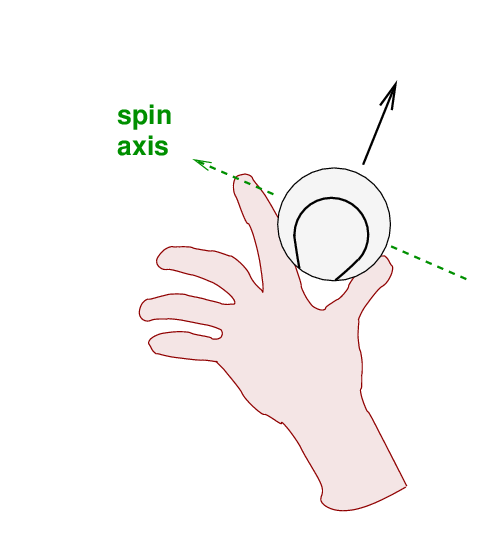
The difference in the grip is obvious in slow motion. Look at how the ball nestles between Sean O'Sullivan's thumb and fingers in the picture below. Click on the image to watch a short video clip in slow motion.
The good news about this technique is that it causes the ball to move in a new direction, one that might befuddle a batter. The bad news is that the lack of support from the two long, strong fingers causes the slider to leave the hand moving more slowly than a true fastball.
I'm afraid that this topic will require a teeny-tiny bit of advanced mathematics. I'll try to keep it simple, but do note that there are a lot of details that I'll be sweeping under the rug.
A ball thrown with no spin will travel along a simple path: nearly a perfect parabola, with just a small correction due to the slowing influence of air resistance. All the "interesting" aspects of pitches -- the rise of a fastball, the dip of a curve, the sweeping arc of a slider -- are due to the interaction of the spinning ball with the air around it. The details of this "Magnus Force" may be a bit complicated, but they boil down to one particular factor: the angle between the spin axis of the ball and the velocity of the ball.
You've seen the spin axis marked in some of the figures shown above. You can locate it by curving the fingers of your right hand around the equator of the ball, pointing in the direction of the spin; then your thumb will point along the spin axis. The velocity, of course, points in the direction that the ball is travelling: from the pitcher's mound to home plate.
As an example, consider a basic fastball, with pure backspin, hurtling through the air. A bird's-eye view of the pitch would look something like this:
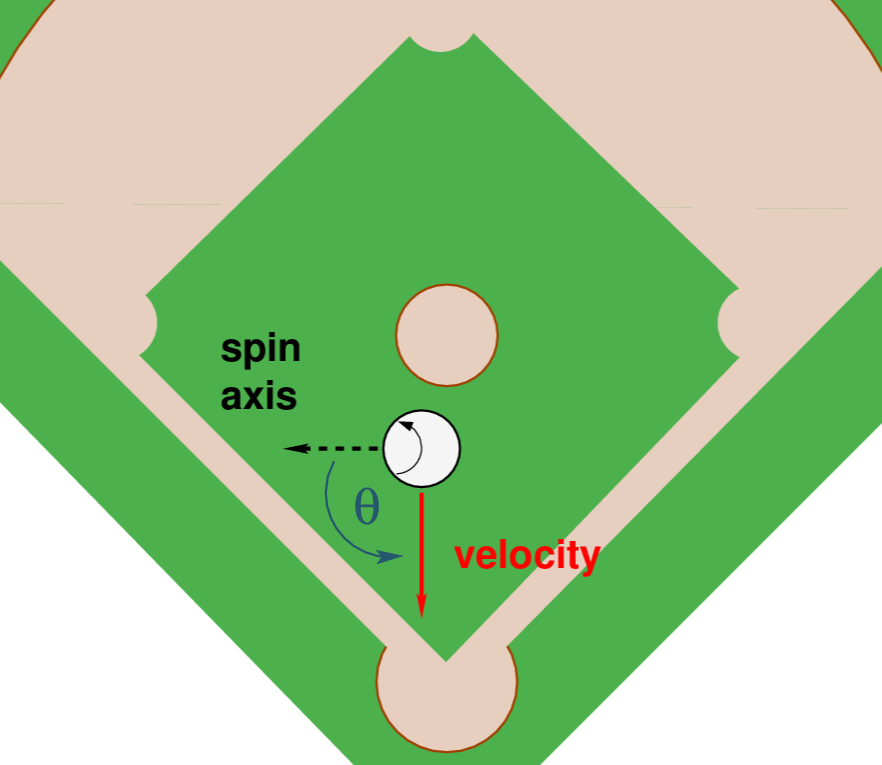
What's the angle between the spin axis and the velocity? A nice, simple, right angle; in other words, θ = 90 degrees.
The Magnus Force depends on this angle (and some other factors, too, but ignore them for now). It turns out that the size of the force includes a term of sin(θ). As you may recall from your math classes, the sine function is largest when its angle is 90 degrees. That means that a ball with pure backspin, moving towards the plate, will experience the largest possible Magnus Force, and thus have the largest possible break. Since the basic fastball grip and release tends to produce this sort of spin, a simple fastball has a lot of break; most of it is upward.
Now, back to the slider. As the pitcher allows the ball to roll up and out between the thumb and index finger, he may twist his wrist, curling his index finger around the outer side of the ball. The motion is not unlike the classic "royal wave:"

This twist and extra contact with the index finger can increase the spin of the ball -- which is good: the faster the spin, the bigger the break. It may also give the pitcher better control of the ball's trajectory -- which is also good. But it may twist the spin axis of the ball, too, pushing it away from third base and towards the batter. And that is NOT good.
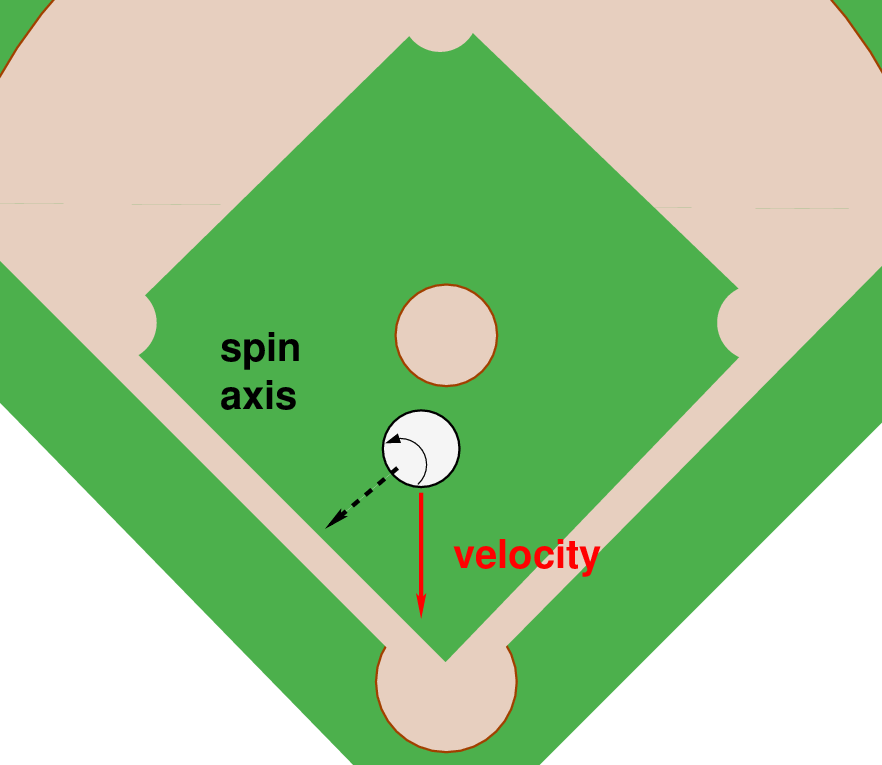
The angle between the spin axis and the velocity has shrunk: in the picture above, it is only θ = 50 degrees. The sin(θ) term shrinks, too, so that the Magnus Force on this pitch will be only about 75% as large as that on a ball with pure backspin.
If a pitcher twists the spin axis even farther, so that it points almost directly at the batter, he will decrease the Magnus Force -- and the break -- even more. In the example below, the Magnus Force is only about one-sixth as large as that on the pure backspin.
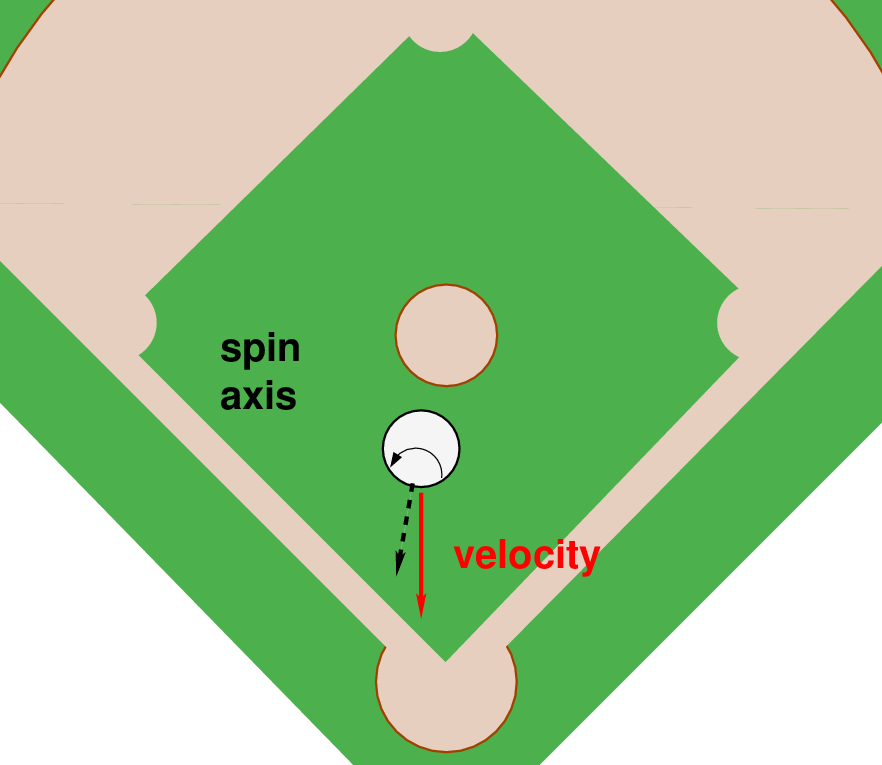
Now, what would happen if a pitcher threw the ball so that the spin axis pointed forward --- directly in line with the velocity? The batter would see a little motionless spot coming right at him, at the center of the spinning surface; something like the ball in this video of a very young Daisuke Matsuzaka.
In this idealized case, the angle θ between the spin axis and the velocity would be zero degrees ... and since the sine of zero degrees is zero, there would be no Magnus Force. The ball would have NO BREAK. In the standard vertical-versus-horizontal-break diagram, this pitch would fall in the exact middle, marked by the big black circle.

There's a name for this kind of pitch: gyroball. Many people have written about it, and even more have talked about it; some of the stories make it sound amazing and completely unhittable. But look where it falls in the graph above: not far from the cloud of symbols marking the slider. If batters can hit a slider, they can certainly hit a gyroball.
In fact, very few MLB players throw pitches which fall in this central region of the "vertical-vs-horizontal-break" diagram. I suspect that the main reason is speed. In order to twist the spin axis into the forward position, one's fingers must grip it mainly on the sides, rather than from behind; like a quarterback does when he throws a nice spiral. That lack of a big push from behind will yield a relatively slow-moving pitch.
So, the slider is a pitch which
How can a pitcher use the slider effectively?
One common situation arises when a pitcher faces a "same-handed batter:" a righty pitcher matched up against a right-handed batter, or a southpaw against a left-handed batter. In these matchups, a fastball will break in, toward the batter, while sliders and curveballs break out, away from the batter. If the pitcher aims a slider toward the outer half of the plate, it will move farther and farther away from the batter as it approaches him, perhaps ending up far outside the strike zone.
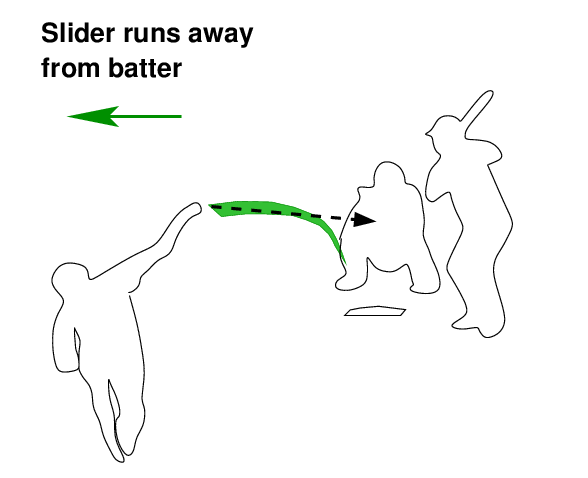
Certain relief pitchers specialize in this type of pitch. Known as "Lefty One Out GuYs" (LOOGYs) or "Righty One Out GuYs" (ROOGYs), they are brought into a game to face dangerous same-handed batters. They usually feed the opponent a steady diet of these "runaway" sliders, tempting the batter to swing at a ball that looks like it ought to be strike ... but isn't.
In the video clip below, taken from a game played May 3, 2016, the Diamondbacks' Kyle Barraclough induces Yasmany Tomas to swing at a "runaway slider."
But this strategy won't work for batters who are "opposite-handed:" the slider won't move away from them, but instead break in towards them. In this situation, a pitcher may choose to throw a slider so that it initially appears to be missing the plate to the outside ... but, as it breaks back inside, it just clips the outer edge for a strike.
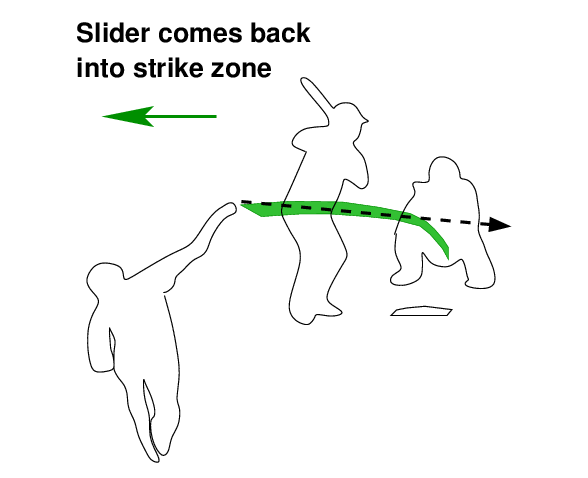
When thrown properly, this backdoor slider is nearly impossible to hit: the batter's first reaction is "that ball is way outside -- let it go." By the time he realizes that it may be a strike, it's too late to swing.
Jose Fernandez of the Marlins executes this strategy perfectly, striking out Jason Heyward to end the eighth inning of a 9-0 win. (Go to 2:52 of the clip below to see the pitch in action)